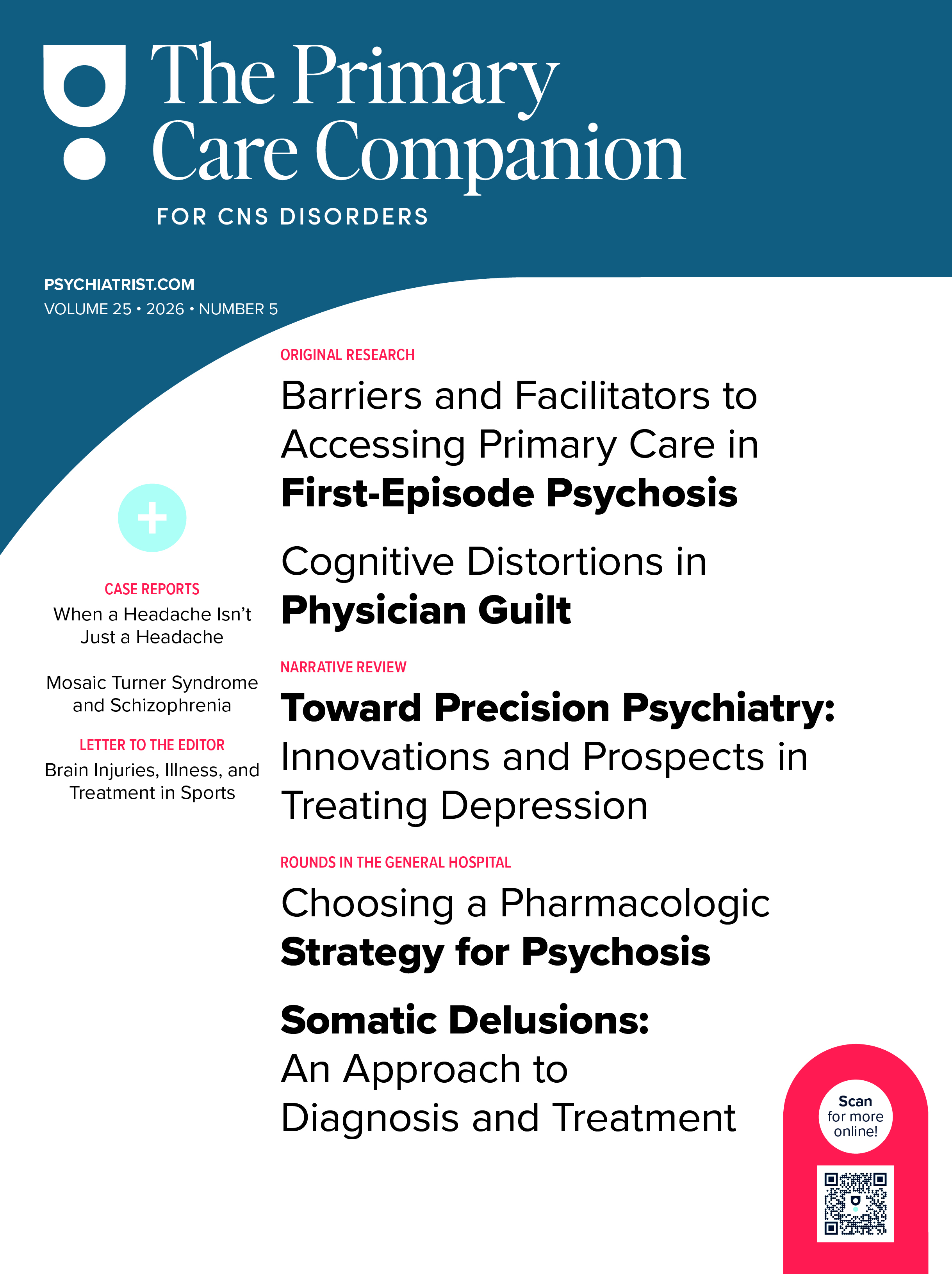Extrapyramidal symptoms (EPS) are commonly associated with antipsychotics and other dopamine receptor–blocking agents. Less is known, however, about the emergence of EPS due to selective serotonin reuptake inhibitors (SSRIs) such as fluoxetine. While a handful of case reports have previously documented this rare adverse effect,1–4 the phenomenon of fluoxetine-induced EPS remains largely understudied, and awareness remains limited among both clinicians and patients. The exact prevalence of this complication also remains unknown, as existing data are primarily derived from isolated case reports and small case series.5 EPS can be profoundly distressing for patients, however, and may even lead to the development of a syndrome known as extrapyramidal-induced dysphoric reactions, characterized by emotional blunting, agitation, and, in severe cases, the emergence of de novo suicidal ideation.6 This side effect is especially concerning for patients with psychiatric conditions, who are already vulnerable to mood instability and suicidality. In this report, we illustrate a rare case of fluoxetine-induced parkinsonism and discuss considerations for clinicians who prescribe fluoxetine.
Case Report
A 34-year-old man with schizophrenia, cannabis use disorder, and tobacco use disorder presented with 3 days of altered mental status characterized by confusion, somnolence, and altered gait. The day prior to presentation, he had been observed vomiting and had multiple episodes of nonbloody diarrhea. On evaluation, his speech was dysarthric and garbled, and he admitted to intentionally overdosing on an unknown amount of valproate. Laboratory results revealed an elevated lactate level of 4 mmol/L and a markedly elevated valproate level of 583 μg/mL. Acetaminophen, ethanol, and salicylate levels were negative. He was admitted to the hospital for management of valproate overdose in the setting of a suicide attempt.
Notably, the patient had been noncompliant with his paliperidone long-acting injection and was discharged from another hospital 3 months prior on a regimen of fluoxetine, quetiapine, and valproate. On physical examination, he exhibited a bilateral pill-rolling tremor of the upper extremities, coarse tremors of the head and arms that worsened with movement and improved with distraction, and mild rigidity. He stated that these symptoms had been present for several weeks.
His presentation was consistent with drug-induced parkinsonism, with fluoxetine suspected to be the contributing agent. Fluoxetine was discontinued, and benztropine 2 mg by mouth twice daily and quetiapine 200 mg every night at bedtime were started after clinical stabilization. His tremors improved significantly within 24 hours and resolved completely within 2 days, with no recurrence on the adjusted regimen.
Discussion
This case highlights the underrecognized risk of EPS, particularly drug-induced parkinsonism, associated with fluoxetine. While EPS are more commonly linked to antipsychotics, we demonstrate that serotonergic agents can also interfere with dopaminergic pathways, especially when combined with other psychotropic medications.7 In our patient, fluoxetine was introduced into a regimen already containing quetiapine and valproate, potentially lowering the threshold for parkinsonian side effects.
The delayed onset and persistence of symptoms prior to admission, coupled with rapid resolution following fluoxetine discontinuation, support a diagnosis of fluoxetine-induced parkinsonism. While rare, SSRI-induced parkinsonism may be underdiagnosed in psychiatric populations wherein tremors are often attributed to underlying illness or antipsychotic use. This case emphasizes the importance of a thorough medication history and high clinical suspicion when evaluating new-onset movement symptoms. Additionally, in patients with polypharmacy, it may not be a single agent but rather the cumulative serotonergic and dopaminergic burden that precipitates EPS.
Given that primary care providers frequently initiate and manage fluoxetine for depression, anxiety, and other mood disorders, appropriate recognition of this potential side effect is essential. Early identification of fluoxetine-induced EPS can prevent unnecessary suffering, reduce diagnostic delays, and ensure more thoughtful prescribing. Increased clinical awareness can ultimately support safer, more effective mental health care across primary care settings.
Article Information
Published Online: October 21, 2025. https://doi.org/10.4088/PCC.25cr03996
© 2025 Physicians Postgraduate Press, Inc.
Prim Care Companion CNS Disord 2025;27(5):25cr03996
Submitted: May 4, 2025; accepted July 28, 2025.
To Cite: Munsar Z, Imtiaz M, Hussain N. Fluoxetine-induced extrapyramidal symptoms: a rare adverse effect. Prim Care Companion CNS Disord 2025;27(5):25cr03996.
Author Affiliations: Department of Psychiatry, Rutgers New Jersey Medical School, Newark, New Jersey (all authors).
Corresponding Author: Zoya Munsar, BS, 185 S Orange Ave, Newark, NJ 07103 ([email protected]).
Relevant Financial Relationships: None.
Funding/Support: None.
Patient Consent: Consent was received from the patient to publish this case report, and all information has been de-identified to protect patient anonymity.
References (7)

- Dutta BK, Saha A, Nagesh IV. Extrapyramidal symptoms after fluoxetine. Med J Armed Forces India. 2015;71(suppl 1):S99–S100. PubMed CrossRef
- Christodoulou C, Papadopoulou A, Rizos E, et al. Extrapyramidal side effects and suicidal ideation under fluoxetine treatment: a case report. Ann Gen Psychiatry. 2010;9:5. PubMed CrossRef
- Diler RS, Yolga AY, Avci A. Fluoxetine-induced extrapyramidal symptoms in an adolescent: a case report. Swiss Med Wkly. 2002;132(9–10):125–126. PubMed CrossRef
- Nizamie SH, Suresh Kumar PN. Fluoxetine induced extrapyramidal symptoms : case reports. Indian J Psychiatry. 1998;40(1):87–89. PubMed
- Jiménez-Jiménez FJ, Molina JA. Extrapyramidal symptoms associated with selective serotonin reuptake inhibitors. CNS Drugs. 2000;14(5):367–379.
- Hamilton MS, Opler LA. Akathisia, suicidality, and fluoxetine. J Clin Psychiatry. 1992;53(11):401–406. PubMed
- Eisenhauer G, Jermain DM. Fluoxetine and tics in an adolescent. Ann Pharmacother. 1993;27(6):725–726. PubMed CrossRef
Please sign in or purchase this PDF for $40.


